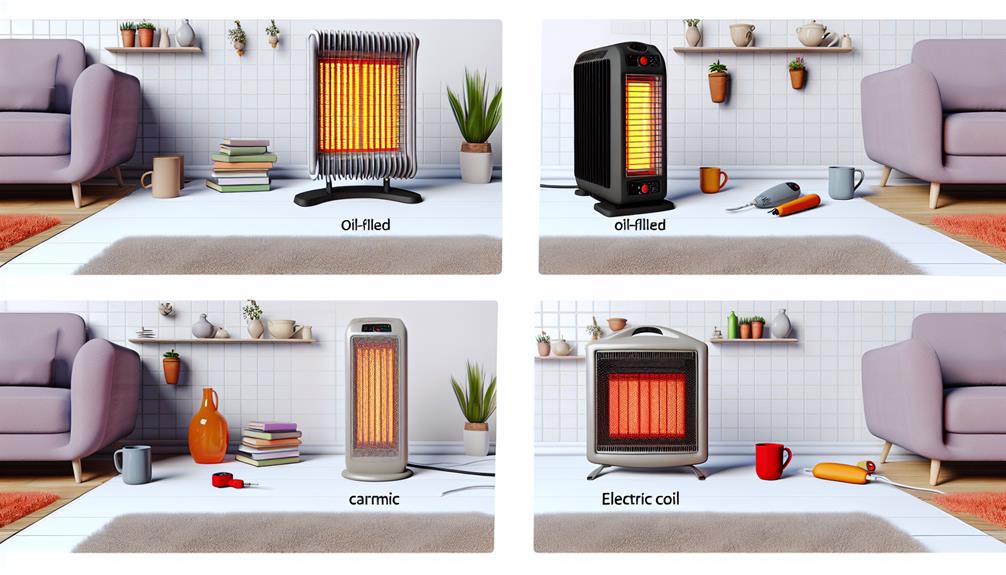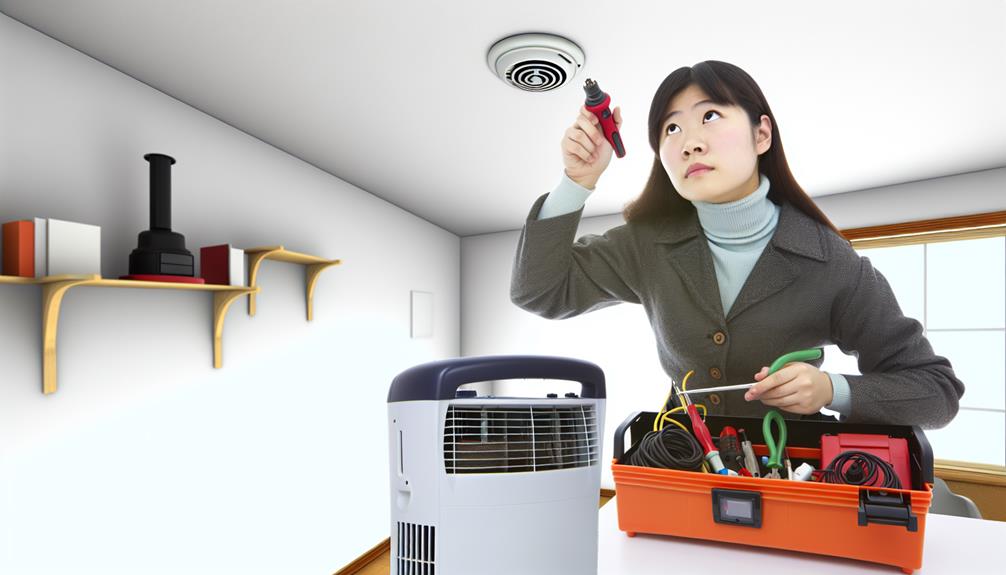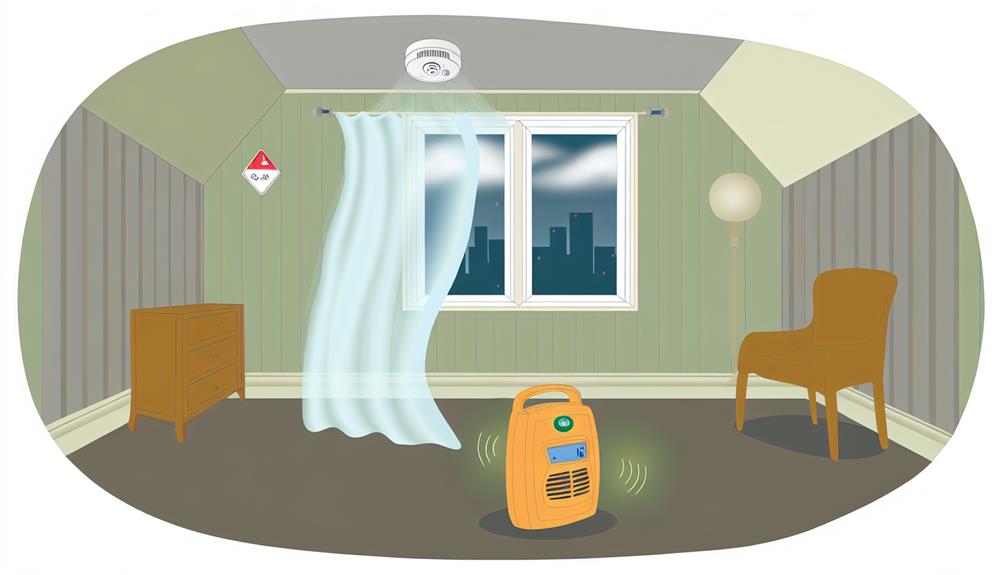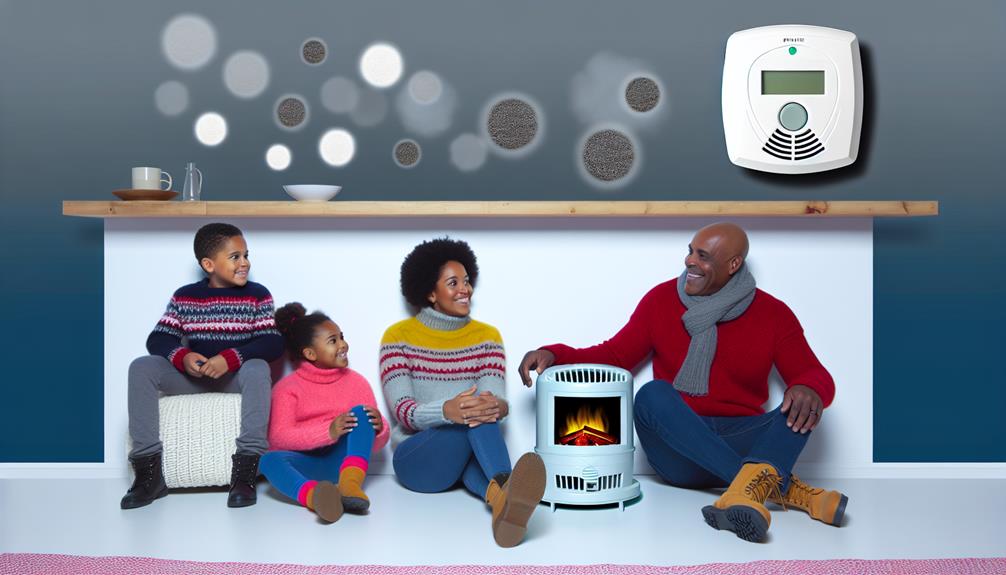As the winter months descend upon us, your portable heater becomes the single most crucial device in your household, warding off the bone-chilling cold that seems to seep into your very soul. You've likely come to rely on this compact source of warmth to create a cozy sanctuary against the frosty air outside. However, while these heaters can be life-savers, they're not without their risks; in fact, if not used wisely, they can become silent but deadly hazards lurking in your living room. You're smart enough to know that safety isn't a mere suggestion—it's a necessity. So, as you nestle into your favorite chair, sipping on a hot beverage, consider how the seemingly simple decisions you make about your portable heater's use could shield you from potential disaster or, conversely, fan the flames of a dangerous situation. Stay with me, and let's uncover how you can keep the warmth in and the risks out.
Key Takeaways
- Choose the appropriate type of heater for your needs and space, considering energy consumption and efficiency.
- Maintain a clear and non-flammable zone around the heater, with a minimum of 3 feet of space.
- Place the heater on a stable, level surface away from foot traffic and combustible materials.
- Regularly inspect and clean the heater, checking for damage, loose parts, and proper ventilation.
Understanding Heater Types

Before selecting a portable heater, it's essential to understand the various types available and their distinct operating mechanisms. Portable heaters can be broadly categorized into electric and combustion-based types, each with subtypes that affect heater efficiency and energy consumption.
Electric heaters, such as convection and radiant models, convert electricity into heat. Convection heaters circulate warm air throughout a room, offering a consistent temperature over time. They're generally more energy-efficient for prolonged use in enclosed spaces. Radiant heaters, on the other hand, provide immediate warmth to objects and people in their line of sight, making them less efficient for heating entire rooms but ideal for quick, targeted warmth.
Combustion heaters burn fuel like propane, kerosene, or natural gas to generate heat. Although they can be highly efficient and effective in open or well-ventilated areas, they pose a greater risk of carbon monoxide poisoning and require strict adherence to safety guidelines to ensure safe operation.
When assessing energy consumption, it's important to consider the size of the space you're heating. A larger, powerful heater won't necessarily be more efficient if it's overkill for a small room. Conversely, a heater that's too small will run continuously, using more energy over time. Additionally, look for models with energy-saving features like programmable thermostats, which can significantly reduce energy consumption by maintaining a set temperature.
To maximize heater efficiency, choose the appropriate type for your needs and space. Careful consideration of energy consumption and efficiency can not only keep you warm but also minimize your environmental impact and reduce your electricity bills.
Proper Placement Guidelines
You must ensure your portable heater is positioned away from flammable materials, maintaining clear surroundings to prevent fire hazards. It's critical to place the heater on a stable, flat surface to avoid any chance of it tipping over. These simple yet effective guidelines will significantly enhance your safety when using portable heating devices.
Maintain Clear Surroundings
Ensuring a portable heater's surroundings are clear of flammable materials is critical for safe operation. Clutter management is essential—not only does it reduce the risk of fire by minimizing material flammability near the heater, it also ensures adequate airflow and prevents overheating. Keep all objects at least three feet away from the heater, be they furnishings, curtains, or personal items.
| Requirement | Detail | Reason |
|---|---|---|
| Clearance | Minimum 3 feet of space | Prevents ignition |
| Non-Flammable Zone | No paper, fabric, or other flammable materials | Reduces fire hazard |
| Ventilation | Unobstructed airflow around heater | Prevents overheating |
| Regular Inspection | Check for accumulated debris | Maintains clear space |
Stick to these guidelines to ensure your safety and the efficient operation of your portable heater.
Stable Surface Requirement
Selecting a level and stable surface for your portable heater isn't just a suggestion—it's a necessity for your safety. Ensuring your heater is secured on a suitable base can prevent accidents and potential fires. Here's what you need to consider:
- Surface compatibility:
- Choose non-flammable, heat-resistant surfaces.
- Avoid placing heaters on uneven ground or elevated platforms.
- Distance importance:
- Maintain a safe distance from all sides of the heater to any flammable objects.
- Ensure the heater is out of high-traffic areas to prevent tipping.
Regular Maintenance Checks

Conducting regular maintenance checks on your portable heater is crucial for safe and efficient operation. It's not just about ensuring it works when you need it most; it's also about maximizing heater lifespan and making the most of any warranty services that may apply. You should always refer to your heater's manual for specific maintenance recommendations, but there are general practices you can follow to keep your unit in top shape.
Here's a concise guide to help you stay on track with your portable heater maintenance:
| Maintenance Task | Frequency | Notes |
|---|---|---|
| Visual Inspection | Before each use | Check for damage or loose parts. |
| Cleaning Air Intake/Grill | Monthly | Remove dust to prevent overheating. |
| Checking Power Cord | Every 6 months | Look for frays or wear and tear. |
| Testing Safety Features | Annually | Ensure auto shut-off is functional. |
| Professional Inspection | As recommended | Follow the manufacturer's schedule. |
Remember that while some tasks, like visual inspections, should be done each time you use your heater, others can be scheduled less frequently. Always unplug the heater before performing any maintenance work. If you encounter any issues during your checks, it's best to consult with a professional or reach out to the manufacturer, especially if your heater is still under warranty. Staying diligent with these checks will not only prolong the life of your heater but will also help ensure that it remains a safe source of warmth in your home.
Safe Operating Instructions
When operating a portable heater, it's critical to adhere to the manufacturer's guidelines to maintain a safe environment. The instructions provided are there to ensure you don't inadvertently create hazards that could lead to fires, burns, or carbon monoxide poisoning.
- Placing Your Heater
- Ensure the heater is on a stable, level surface, away from foot traffic.
- Keep it at least three feet away from combustible materials like curtains, furniture, or bedding.
Following the correct thermostat settings is also paramount to both safety and energy efficiency. Don't crank the heat up too high; it's not only a safety risk but can also overwork the unit. Instead, find a comfortable thermostat setting that maintains the room at a consistent, safe temperature.
- Using Heater Timers and Controls
- Utilize heater timers to automatically turn off the unit after a certain period, especially when you're sleeping or away.
- Adjust thermostat settings to lower temperatures when the room is unoccupied.
By using heater timers, you can prevent the unit from running unnecessarily long, which not only conserves energy but also reduces the risk of overheating. Thermostat settings should be adjusted according to the room usage – a lower temperature when the room is not in use can prevent overheating and save on your energy bill.
Always supervise children and pets when a portable heater is in use. They may not understand the danger and could accidentally knock it over or burn themselves. And remember, never leave a heater running unattended or while you're asleep without proper safety features like an automatic shut-off.
Ventilation Considerations

While focusing on the correct placement and use of your portable heater is essential, it's equally important to consider the ventilation in the space to prevent dangerous air quality issues. Proper ventilation ensures that any fumes or particles produced by the heater can dissipate, reducing the risk of respiratory problems or fire hazards. It's crucial to account for room size when determining the adequacy of ventilation. Smaller spaces can become quickly saturated with contaminants, so additional measures may be necessary to maintain air quality.
Ensure that your chosen room has sufficient airflow patterns to support the use of a portable heater. For rooms without built-in ventilation or windows that can be opened, consider using exhaust fans or cracked doors to facilitate the exchange of indoor and outdoor air. Remember, stagnant air increases the potential for harmful pollutants to accumulate, especially in tightly sealed environments.
Regularly check that vents and air intakes are unobstructed and clean, as blocked pathways can severely diminish ventilation effectiveness. Additionally, be aware of the type of heater you're using. Combustion-based portable heaters, such as those that run on kerosene or propane, require ample ventilation to prevent the buildup of carbon monoxide—a colorless, odorless gas that can be deadly in high concentrations.
For electric heaters, while the risk of emissions is lower, they too can contribute to poor air quality if they cause dust and other particulates to circulate. Maintaining a clear space around your heater not only prevents objects from overheating but also promotes better air circulation. Keep in mind, safety is paramount when heating your space—adequate ventilation is a key component of this.
Child and Pet Safety
When you introduce a portable heater into your home, it's crucial to ensure the safety of children and pets. You'll need to establish clear boundaries to keep curious hands and paws at a safe distance and ensure the heater is positioned securely to prevent tipping. Additionally, take the time to educate everyone in the household on safe usage to mitigate the risk of accidents.
Establish Safety Boundaries
To ensure the safety of both children and pets, it's crucial to establish clear boundaries around portable heaters. When selecting a heater, consider its heating capacity and look for models with safety certification. This ensures they've been tested for stability and surface temperature control—key factors in preventing accidents.
- Create a Safety Zone:
- Keep heaters at least 3 feet away from beds, curtains, and play areas.
- Use physical barriers such as baby gates to demarcate the no-go zone.
- Educate and Supervise:
- Teach children the importance of keeping a safe distance from heaters.
- Always supervise pets and young kids when heaters are in use to reinforce these boundaries.
Secure Heater Placement
Ensuring your portable heater's stability is paramount to prevent it from being knocked over by curious children or pets. You've got to place it on a level, non-flammable surface far from foot traffic and play areas. Remember, heater aesthetics shouldn't trump safety; a secure spot may not always be the most visually appealing. Always use a heater with a wide base or a tip-over safety switch, especially in homes with active kids and animals.
As seasons change, proper seasonal storage is crucial. Store the heater in a cool, dry place where it's out of reach. That way, you're not only prolonging the life of your heater but also ensuring it's safely tucked away from playful hands and paws until needed again.
Educate on Safe Usage
Educating yourself and your family on the safe operation of portable heaters is essential for preventing accidents involving children and pets. It's vital to:
- Stay Informed
- Check for heater recalls regularly to ensure your device isn't a known hazard.
- Register new heaters for alerts on safety issues.
- Implement Safe Practices
- Use usage timers to automatically shut off heaters, reducing risk when you're not present.
- Keep heaters out of reach from kids and pets.
Ensuring that everyone in the household understands the importance of these steps is crucial. Teach children to stay clear of heaters and never leave pets unattended in a room with an operating heater. Remember, the right knowledge can prevent accidents and keep your loved ones safe.
Fire Prevention Strategies
Implementing strict guidelines for the placement and usage of portable heaters can significantly reduce the risk of accidental fires. It's essential to ensure that your electrical systems are up to date and regularly inspected. Faulty wiring and overloaded circuits are common culprits in heater-related fires. Professional electrical inspections can catch these issues before they escalate. Moreover, smoke detectors play a critical role in early fire detection and should be installed on every floor of your home, especially near bedrooms and living areas.
Here's a quick-reference table to guide you in fire prevention strategies:
| Strategy | Description | Implementation Timeframe |
|---|---|---|
| Electrical Inspections | Check for outdated or faulty wiring. | Annually |
| Smoke Detectors | Install and test detectors regularly. | Immediate & Monthly |
| Heater Placement | Keep heaters at least 3 feet from combustibles. | Before each use |
| Supervision & Maintenance | Never leave heaters unattended; clean regularly. | Ongoing |
You'll need to be vigilant about where you place your heater. Keep it at least 3 feet away from any combustible materials, such as curtains, furniture, or bedding. This buffer zone is critical to preventing fires that can start when heat builds up near flammable objects.
Lastly, don't forget to maintain your heater. A well-maintained heater is less likely to malfunction and cause a fire. This means regularly cleaning it to prevent dust buildup and always turning it off when you're not in the room. It's simple: no supervision, no operation. By following these authoritative, informed steps, you're actively minimizing fire risks associated with portable heaters.
Carbon Monoxide Awareness

While focusing on fire safety, it's also crucial to be aware of the invisible threat: carbon monoxide (CO) can silently emanate from malfunctioning portable heaters, posing serious health risks. It's odorless and colorless, making it undetectable without the proper equipment. That's why it's imperative you install CO detectors in your home. Here's what you need to know:
- Detector Installation
- Install detectors near sleeping areas to ensure you're alerted even while asleep.
- Regularly test and replace batteries, at least twice a year, to maintain functionality.
Being informed about CO poisoning symptoms can mean the difference between life and death. Early recognition of these signs is essential:
- Poisoning Symptoms
- Sudden dizziness, weakness, or headaches may indicate mild exposure.
- Nausea, chest pain, and confusion are signs of higher levels of poisoning.
If you suspect CO poisoning, it's vital to act swiftly. Get to fresh air immediately and seek medical attention even if symptoms seem to subside; some effects can be delayed or long-lasting.
Remember that prevention is always preferable. Ensure your portable heaters are properly maintained and never use them in enclosed spaces without adequate ventilation. It's your responsibility to keep your environment safe from the silent killer that is carbon monoxide. Stay vigilant and take these precautions to protect yourself and your loved ones.
Emergency Preparedness Measures
ARTICLE TITLE: Avoiding Common Hazards: Safe Practices for Portable Heater Use
PREVIOUS SUBTOPIC: 'Carbon Monoxide Awareness'
CURRENT SUBTOPIC: 'Emergency Preparedness Measures'
Armed with the right knowledge, you'll be better equipped to handle unforeseen events, starting with an emergency plan that includes a designated safe space and evacuation routes in case your portable heater sparks a fire. It's imperative to be proactive; disaster kits and strategies for power outages must be at the core of your emergency preparedness.
In the event of a fire, quick and decisive action can save lives. Ensure that everyone in your household knows the location of fire extinguishers and how to use them. Also, keep a list of emergency contacts in a readily accessible location. Remember, during power outages, cellular networks may be compromised, so a battery-powered radio could be your best source for updates.
Here's a table that resonates with the gravity of being prepared:
| Emergency Item | Emotional Impact |
|---|---|
| Disaster Kits | Peace of Mind |
| Evacuation Plan | Security |
| Communication | Connection |
Your disaster kit should include essentials such as food, water, a first aid kit, flashlights, and extra batteries. Tailor it to the unique needs of your family, including pets. Always keep your kit updated and stored in an accessible location.
Lastly, don't underestimate the importance of drills. Regularly practicing your evacuation plan can instill a calm sense of readiness rather than panic when every second counts. Preparedness isn't just about having the right tools; it's about cultivating the right mindset. Stay informed, stay ready, and never take safety for granted.
Frequently Asked Questions
What Are the Insurance Implications of Using Portable Heaters in a Residential Property?
Nearly 80% of heating fire deaths involve portable heaters. When you use these devices, it's essential to understand the insurance implications for your home. Portable heaters increase fire hazards, potentially affecting your policy coverage. Ensure you're aware of the terms and conditions, as negligence could void your claim. It's critical to operate heaters safely to protect not only your property but also your insurance standing in the event of an incident.
Can Portable Heaters Be Used Safely in a Bathroom or Other High-Humidity Areas?
You can use portable heaters in a bathroom, but it's crucial to ensure they're designed for high-humidity areas. Look for models with moisture resistance to maintain bathroom safety. Always follow the manufacturer's guidelines to prevent any electrical hazards. Keep the heater away from water sources and never touch it with wet hands. By choosing the right heater and using it carefully, you'll keep your bathroom warm and safe.
How Does the Use of Portable Heaters Affect Electricity Bills Compared to Central Heating Systems?
Portable heaters can be a double-edged sword for your electricity bill. Unlike the broadsword of central heating, which heats the entire home, portable heaters, when used for zone heating, can be more energy-efficient, targeting just the areas you use. However, they're often less efficient overall compared to modern central systems. So, while they might reduce your heating costs in certain scenarios, they could also lead to higher expenses if not used judiciously.
Are There Any Health Benefits or Risks Associated With Using Infrared Portable Heaters Over Conventional Ones?
You're considering infrared heaters for their efficiency, but it's crucial to weigh potential health impacts. These heaters are lauded for efficient, direct warmth, yet concerns linger over electromagnetic emissions. While no definitive evidence suggests serious health risks, it's wise to use them moderately. Ensure you're not exposed excessively and follow manufacturer guidelines to mitigate any potential risks. Always prioritize well-ventilated spaces to maintain air quality when using any type of portable heater.
Can Portable Heaters Be Safely Used With Extension Cords or Power Strips?
You're playing with fire if you think extension cords and power strips are ideal dance partners for your portable heater. Let's cut to the chase: plug it directly into the wall. Heater placement isn't a game of musical chairs, and proper ventilation isn't just a breath of fresh air—it's non-negotiable. Treat those safety instructions like your life depends on it—because, frankly, it does. Stay warm, but more importantly, stay safe.
